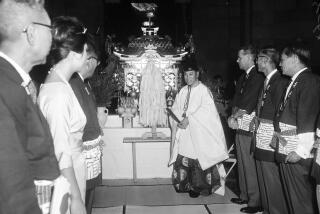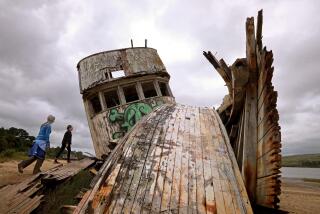Galleon’s Cargo Full of Puzzles
- Share via
The Spanish galleon had just left the Philippine province of Palawan carrying three bronze bells for the newly constructed Catholic missions in California when it was attacked by Moro pirates.
Knowing that capture meant certain death, the crew fought off the marauders until a cannon on the galleon exploded, triggering a secondary explosion that sank the ship. That was in the late 1700s.
The as-yet-unidentified galleon lay 170 feet deep, hidden in a shipping lane in the South China Sea.
Now, an American explorer and Philippine archeologists are recovering the ship’s cargo from the ocean’s murky depths, revealing new insights into trade practices in a time and place about which little was known.
The team has so far recovered only a few hundred of the more than 5,000 artifacts thought to be present, but the variety of the discoveries has provoked as many questions as it has answered.
Much of the vexing mix of cargo does not seem to jibe with the geographic location and the time period when the ship was sailing. The cargo comes from throughout the world, including Chinese pottery from three dynasties, a corn-grinding tool from Central America and a single avocado seed from what is now the United States.
“The mixture of artifacts makes no sense,” said San Pedro-based salvor Steve Morgan of Black Coach Management Inc. “It’s like a big museum sank, rather than a ship.”
The most important part of the recovered cargo, the mission bells, disappeared soon after native divers stumbled onto the wreck last year, however, and the team has so far tracked down only one of them.
The team has been at the site for more than four months, documenting it and then beginning the tedious and exhausting process of bringing artifacts to the surface. Weather has been a major problem. “We’ve had a grand old time dodging hurricanes and typhoons,” Morgan said by telephone last week.
Weather permitting, the team hopes to have recovered all the artifacts by the end of October. The effort is time-consuming because of the depth, which allows divers to make only one 30-minute dive per day.
The remains were found by local divers who came upon what they described as “a reef on the bottom that is not really a reef.” That “reef” proved to be the ship’s cargo, arranged in a pile 60 feet long, 4 feet high and 20 feet across. If the cargo hold was that big, that means the ship itself was at least 100 feet long, Morgan said.
Not much is left of the wooden ship. But the remains that have been found were held together by iron spikes, indicating that the ship is most likely Spanish in origin, according to Morgan. Chinese ships from the period were held together with wooden spikes.
“Now we really need to find out its name,” said Cecilio Salcedo, assistant director of the Philippine National Museum. One of the ships lost during the period, the San Antonio de Padua, is near the top of their list, said Morgan. But another vessel, the Princessa, also is being researched.
Five bells have been recovered from the wreckage: three large, one medium and one small. The small one is a “Mass” bell used during the Catholic service. It stands about 7 inches tall and is inscribed SJ Evang, which stands for St. John the Evangelist. No date is on the piece, and it is believed to have been owned by a Jesuit priest.
The second bell, about 1 1/2 feet tall, is bronze and is inscribed S. Joseph 1783. Because of its mounting, it may have been associated with the ship. “That’s not necessarily the name of the ship, but may be one of the saints protecting it,” Morgan said.
The three other bells, each about 3 feet tall and weighing 800 to 1,000 pounds, have the traditional “crown” mount that was used only in churches and missions. Morgan has inscriptions from just two. One says San Antonio and 1784, while the other says San Jose and 1783.
Because of the names and dates, Morgan thinks the bells might have been destined for California missions. The San Antonio mission, about 5 miles from Jolon in Monterey County, was established in 1771 and could have been the destination of the first. But the San Jose mission was not established until 1797, so the destination of that bell remains unclear.
According to records of the Catholic church, bells for the missions were made in Russia, China, Japan and Burma. Because the cargo of the ship came from Singapore, Borneo and elsewhere in southern Asia, Morgan suspects these bells were cast in Burma.
To the displeasure of Philippine authorities, all three mission bells disappeared, and were presumably sold to collectors. They’ve located one, Morgan said, but the other two are reported to have been sold to a collector named “Phil” in California.
Philippine authorities have distributed pictures of the bells to U.S. customs officials and have offered a reward of 100,000 Philippine pesos (about $2,226) for their return.
Other discoveries in the cargo are more puzzling. The large quantity of pottery on board comes from three Chinese dynasties: the Sung (964 to 1368), Ming (1369 to 1644) and Qing (1645 to 1912.)
“Nobody has been able to explain why,” Morgan said. “Normally, artifacts date from within 50 years of a wreck, not 800 years. We don’t know if it was personal possessions or what.” The pottery might have been the property of Spanish settlers fleeing back to Manila to escape the Moro, he added.
Also on board was a granite metate, a three-legged Central American implement for grinding corn and cacao. “It’s good only for grinding corn, and there was [no corn] in Asia,” Morgan said. “What this is doing in the South China Sea has stumped everybody.”
*
Another intriguing find was “a beautiful gourd-like jar, made to look like a pumpkin.” The jar contained one avocado seed, packed in dry sand and then sealed. Avocados are native to the Americas, but not to Asia. The dry sand and the lack of light in the jar would have kept the seed from germinating until it reached its destination.
“This shows us how valuable they thought an avocado seed was,” Morgan said. “This is the first time it’s been proven how they were transported.”
But the key discovery for deciphering the ship’s fate was a broken cannon. “Cannons only broke because they exploded while being fired,” Morgan said. “So that gives us a clue that they were fighting somebody off in their last hours, or the cannon wouldn’t have been there.”
And that somebody was most likely Moro pirates, an indigenous Muslim group that “hated Christians and hated the Spanish,” Morgan said. The Moro spent most of the 18th century trying to drive the Spanish out of the Philippines, and one tactic was attacking the Spanish galleons that plied the trade routes. This ship apparently fell victim to them.
The fact that the cargo is intact indicates that the ship sank before it could be looted, perhaps as a result of a second explosion triggered by the cannon.
Morgan is, in effect, a treasure hunter whose previous exploits have included the discovery of wreckage of the USS Kearsarge, the last of the Navy’s wooden warships, off the coast of Colombia, and the luxury steamship Atlantic in Lake Erie.
His company will share the artifacts with the National Museum. All one-of-a-kind artifacts will go to the National Museum, but when there is more than one item, they will be split 50-50, according to Rodolfo Puno, head of United Asia Ocean Quests Inc, which is working with Black Coach to retrieve the booty.
Maugh can be reached at [email protected].
More to Read
Sign up for Essential California
The most important California stories and recommendations in your inbox every morning.
You may occasionally receive promotional content from the Los Angeles Times.










